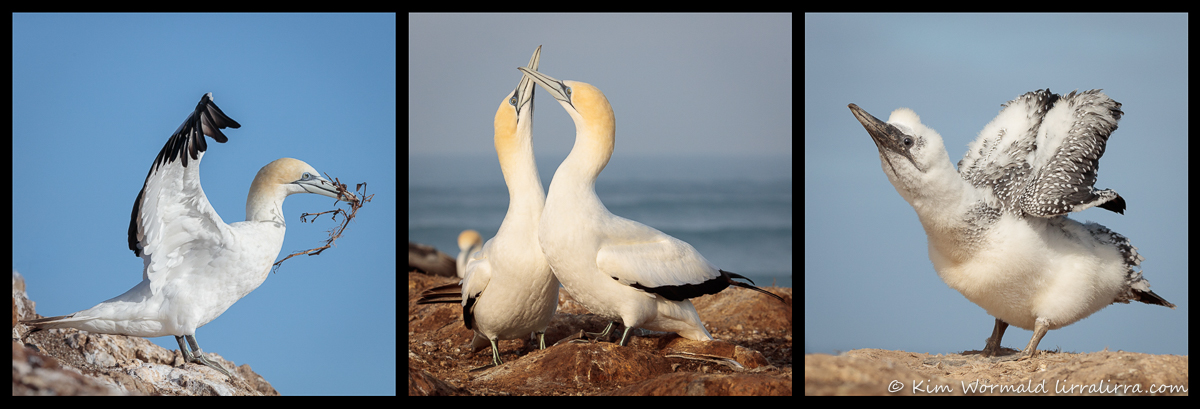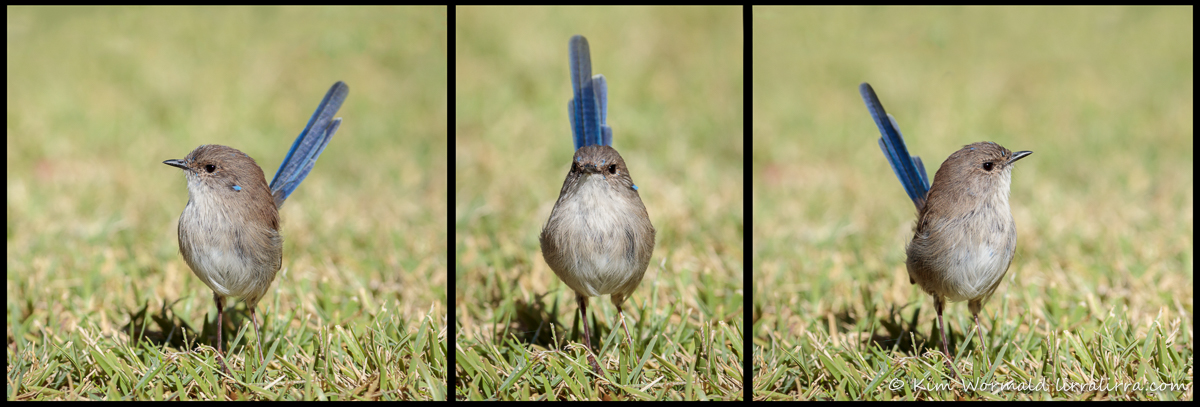Once a year I’m challenged to create a triptych, a series of three images that tells a story.

“Gannet Breeding Season”
Australasian Gannet (Morus serrator)
1/3200, f/11, ISO 1600 1/1600, f/11, ISO 1600 1/2500, f/9, ISO 800
Ideally the background of a triptych will line up nicely, with a matching horizon or integrated foreground. Ideally the colour palette will be consistent. These ideals weren’t possible with images taken at different times, across a breeding season at the Point Danger gannet colony. Despite the lighting differences this triptych (which rhymes with ‘pic’) definitely tells a story.
Gannets are large seabirds found in Australia and New Zealand. They prefer to breed on offshore islands or manmade structures in the ocean but when those options are taken they spill over onto onshore promontories such as Point Danger in Victoria and Cape Kidnappers in New Zealand. The breeding season usually begins around October with the last of the fledglings leaving the area around March.
Gannets collect all kinds of bits and pieces to create their ‘nests’ including seaweed. They often play with what they’ve collected, tossing it into the air before showing it to their mate. Their pair-bonding rituals are the well-known fencing movements when they quickly, yet gracefully, tap their bills together while bobbing and calling.
The chicks wait patiently for their parents to return from the feeding grounds. I have some interesting shots of feeding that I will share soon. Chicks take between two and five years to develop their adult plumage.

“One Second of Vigilance”
Superb Fairy-wren (Malurus cyaneus)
1/1600, f/7.1, ISO 800
The story in this Superb Fairy-wren image lasted less than one second and illustrates the constant vigilance that is part of a bird’s life. Fairy-wrens forage frequently and are always looking around for potential threats such as birds of prey, cats, foxes and lurking photographers.
The bird above is a male in the final stage of losing his breeding plumage. He has several tiny blue feathers remaining on his head and one larger blue feather that is more easily seen.

“Bird Photography”
White-naped Honeyeater (Melithreptus lunatus)
1/800, f/5.6, ISO 800
Several years ago I made the “Bird Photography” triptych above, featuring a White-naped Honeyeater as it perched, turned and flew away. I remember a wildlife photographer mentioning that bird photography is the most difficult genre, small birds certainly don’t sit still for long but I’d rather photograph them than charging hippos.
These tiny honeyeaters are about 14cm long and weigh approximately 13g. They feed mainly on nectar which is supplemented with insects. They are usually quite sleek looking, unlike the fluffed-up version in the image above.
Happy birding
Kim
~ thank you for visiting and commenting
~ use the subscribe box if you’d like to receive a weekly email when lirralirra is updated

I love these to the moon and back miss! Fabulous!
Hi Sherry, for some reason your comment has me wondering how many of the fairy-wrens and honeyeaters could sit together on a gannet’s bill – very random!
Love the fairy wren one! Thanks for you weekly email, I really look forward to them.
That was the trickiest one to put together Donna, when I thought it would be the easiest. Your kind comment has made me type extra quickly so I can work on the new post, I’ve been a bit delayed today.
Well worth the effort though , so cute and cheeky looking!
Ooooh. And ahhh.
And thank you.
No favourites today, though the gawky gannet melts my hard heart.
I’ve always thought of the gannets as being graceful but I think you’re right, they are definitely on the gawky side!
Gorgeous triptychs! I love that all tell a story.
It’s remarkable how long the gannet chicks take to get their adult plumage!
They’re babies for a long time for sure, and so cute too
exquisite kim, hard to pick a no.1 (though as you know i am a fairy-wren fanboy)
Thank you. I like the one second story, small birds have to be so vigilant all the time, as you know